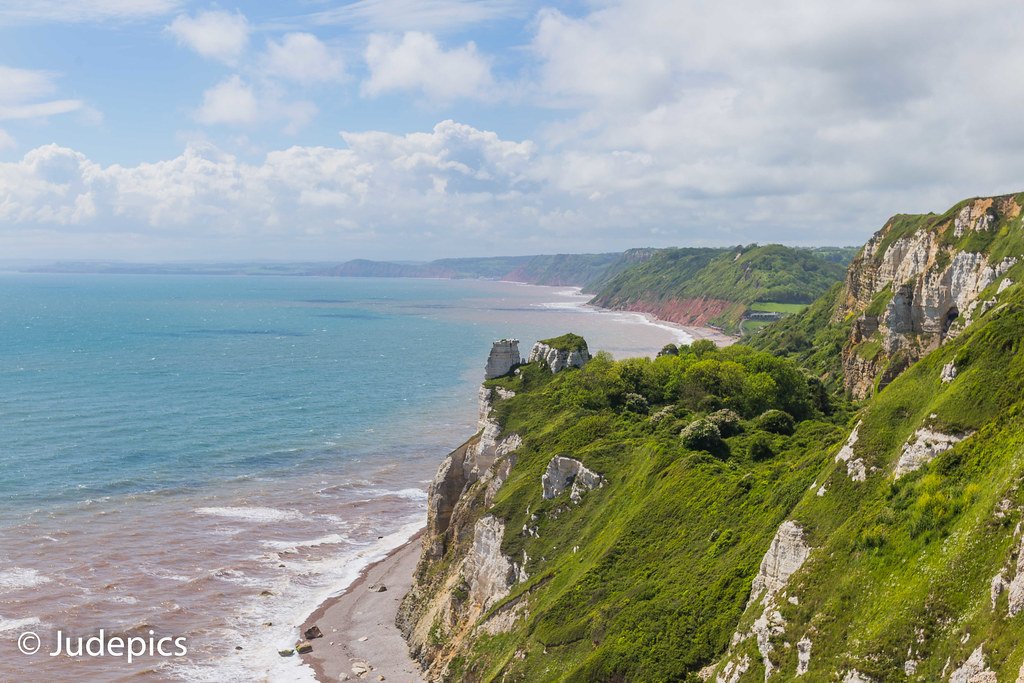
During my epic and somewhat barmy quest to walk the entire South West Coast Path (SWCP), I encountered a strikingly rich diversity of people and places. In part 2 of my travelogue, I offer a few (hopefully entertaining) anecdotes about some of the eccentric individuals I met, the shoddy B&Bs I’d rather not have stayed in and the nicest pubs I stumbled across in search of much-needed real ale at the end of a long day’s hiking.
Is there a SWCP ‘type’?
It’s hard writing objectively about coast path walkers, being myself one of this frequently spotted species, but here goes! The SWCP walker is a sociable creature who often moves in groups of like-minded individuals, bantering loudly as they go, often to the dismay of those seeking quiet and solitude. They are overly fond of the paraphernalia of hiking, which means they are seen with map cases festooned around their necks and GPS at the ready, when the only real navigation advice required on a coast path would seem to be ‘keep the sea on your right’. (This only applies if walking the trail anti-clockwise of course; if you’re going the other way, the advice could result in an unexpected dip.)
The hiker’s plumage is colourful and acquired from Go Outdoors, Millets or, for the better-heeled hiker, Rohan. There is a dowdier sub-species that tends to be disinterested in the garbage of garb and buys their kit on the basis of value for money and effectiveness, rather than colour coordination.
Other noteworthy and contrasting character-types you are likely to encounter along the SWCP and its surrounding towns and villages are:
- the ‘cool surfer-types’, many of whom are pretending to be in their early twenties, with highlighted hair and a California tan (from a tanning booth in Wigan), clad either in wet suits or figure-hugging t-shirts, as they head to the nearest beachfront bar;
- the ‘National Trust (NT) types’ in their tweed ensembles and brown brogue shoes, carrying binoculars; their natural habitat is the tea rooms of stately homes, which they frequently behave as if they own, along with the coast path viewpoints within no more than 100 yards of a NT car park. (I know you should not generalise, so I’d better acknowledge that many are incredibly friendly, good humoured and down to earth; but I find the behaviour of some of the cake-chomping, walking-stick-wielding, tie-wearing (on sunny days), child-hating, Daily-Mail-reading, horticulturally aware, down-the-nose-gazing, tourist-hating (because of course “We are not tourists!”) National Trust members rather irritating – and I say that as a great admirer of the charity and a long-time member.); and, lastly, I dedicate a separate category solely to …
- ‘the least amenable of all SWCP types’ – those who have an uncanny ability to brush past without a word, or any other glimmer of recognition, and an apparent inability to ‘give way’ when passing along the narrowest stretches of coast path!
The kindness of strangers
Despite some less-than-hospitable encounters, three incidents out on the trail served to restore my faith in human nature.
Sat outside a Lynmouth sandwich shop, while my partner, Pat, bought provisions, I overheard a conversation between a man emptying the litter bins and a well-dressed, ‘arty-looking’ lady. It seems that this man’s wife had left him two months ago; the lady was being very kind, telling him that he should not “hide away” – not the last instance of faith-restoring kindness that I was to see.
Another heartwarming incident involved three lady hikers I met at breakfast on my first morning in Bideford. On the basis of the entirely superficial indicator of accent, I pigeon-holed them as ‘middle-class, stuck-up, right-wing harridans’. Chatting to them again on my second day I realised my error.
An appetising breakfast conversation about the joys of using an outside toilet during a hard frost – which I felt compelled, and indeed eminently qualified, to join in – proved that I was definitely wrong. They turned out to be a jolly trio of old friends, who were knocking off the SWCP over a long weekend every year. When asked if I was being sponsored I gave my stock reply – that fundraising was by no means the main objective of the walk, but that people were sponsoring me for a homelessness charity. I felt even more embarrassed by my snap character-assessment (or character-assassination) when one of them re-appeared after breakfast and gave me £15.
I was extremely touched by this gesture of genuine kindness and their clear concern for people less fortunate than themselves. As well as swelling the charity’s coffers, it also taught me a valuable lesson.
I was also moved by the rather eccentric lady owner of our Fowey B&B, who surprised me as I left by giving me an envelope containing a contribution to my charity sponsorship. She may have been a bit quirky but was undoubtedly a good soul.
B&B owners – unemployable in any other profession?
I mentioned in Part 1 several fantastic B&Bs, all of which I would happily stay at again and heartily recommend. However, one of my most surprising discoveries was that other examples of this allegedly great British institution were so bad as to be laughable. This observation led one of my friends to say that, after similar experiences, he’d concluded that many B&B owners would be “unemployable in any other profession’. I thought him a little harsh at the time, but on reflection I’m not so sure.
Price was no indicator of value; often the correlation was so weak that I could not escape the conclusion that some B&B owners are taking the mickey. With notable exceptions, some of the places we stayed in seem to aspire to no more than the very minimum standards of service and – far from going the ‘extra mile’– appear to be only in it for the money.
First inductee to my ‘B&B hall of shame’ was in Clovelly. Despite its charming name, our B&B was a charmless establishment. Sixty pounds secured an attic room, with no wardrobe space or en-suite facilities. I would not really have objected to the lack of an en-suite bathroom if the shared bathroom had not been one floor below and shared by the whole house, including the proprietor and his family. Having noticed a bath, I was about to comfort myself with a nice soak after a hard day’s walk, but then I realised that the bath plug had been removed to prevent residents using too much hot water. Make yourself at home!
In Tintagel I was given a well-appointed but extremely small room. For me the only truly ‘magical’ thing about this Tintagel guest house was how they had managed to get a toilet and shower into that Lilliputian room – the work of ‘Merlin the Plumber’? I certainly couldn’t have held a cat-swinging competition there.
The totally inadequate directions we’d been sent meant that we had trouble finding our accommodation in Porthcothan – and very bizarre accommodation it was too! After wandering around asking directions we eventually found our B&B, in a private house. Failing to make ourselves heard at the door, we spotted a note informing us that the proprietor was out and that we should let ourselves in and make a cup of tea. So far, so good.
Things started to go downhill rapidly though when we entered our room: a room with one coat hanger, no shampoo or shower gel and no TV. As we didn’t have much worth hanging up and are not telly addicts or obsessive bathers, none of this presented much of a problem. However, we were taken aback when ‘mine host’ appeared and – ignoring any small talk – asked urgently: “How early can I persuade you to have breakfast in the morning?” It turns out that she was a photographer and wanted to go out on a job at the crack of dawn. As rude a welcome as any we received on the SWCP, or anywhere else for that matter.
The next morning we breakfasted alone, after our host dropped off our breakfast and ran down the drive asking, over her retreating shoulder, if we could let ourselves out! Although we didn’t know it at the time, our sojourn there was the first of four consecutive nights featuring the worst B&Bs I have ever stayed in.
Our next stopover, in Newquay, conformed to the ‘seaside guesthouse’ stereotype. Perhaps the people here haven’t realised that the war is over, but rationing was still in force at breakfast, with portion-controlled cereal and fruit juice (pre-poured into bowls and glasses). I came across this sort of parsimony at other establishments and always had the same thought – that the savings gained by such austerity measures must be far outweighed by the loss of goodwill and potentially poor reviews.
Third in the Cornish quartet of tawdry billets was in Perranporth. It looked promising from a distance (say, a mile away), but as I approached along the badly cracked concrete path I became less optimistic.
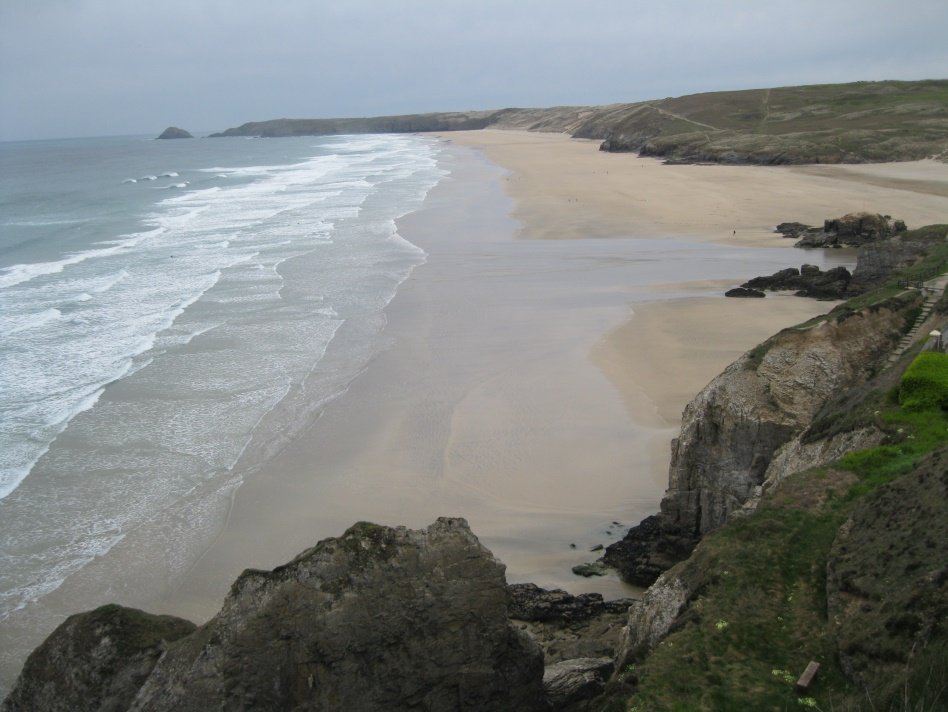
Perran Sands – the best view, from the worst B&B
In its favour, it did have a superb view: a panoramic sweep of Perran Sands. On the other side of the ledger were a number of less positive features, including the fact that the establishment was run by a couple straight from a Hammer horror movie set in the East End; operated strict portion control at breakfast; provided no toiletries in the bathroom; and expected me to sleep in the smallest bed I’ve seen since I was in short trousers.
‘Lowlights’ of our stay included:
- a welcoming sign by the door advising guests that payment must be made the night before departure;
- being offered an upgrade to a double room but, after agreeing to sleep in the single bed, discovering that the ‘single’ was, in fact, a child’s bed. The room was clearly a ‘family room’ and I slept with my legs hanging well over the end of the bed and my neck straining to watch the miniature TV, which was thoughtfully positioned on my bedside table, so that it could be viewed from the double bed on the other side of the room. This meant that, to view the telly, I had to perform an act worthy of a skilled contortionist. (To be fair, by turning my body sideways, I found I did have a good view – not surprising really since my eyes were then only about 6 inches from the screen);
- having to carefully negotiate a threadbare carpet, partially repaired with broad gaffer tape, and then work out how to prevent the shower from falling apart, fixed precariously as it was to the wall;
- discovering that the rusting tea tin contained but one solitary teabag, which looked to have been there since the Coronation in 1953. The coffee was equally unappealing, being stored in an old, stained jar without a label and looking as if it had seen several seasons’ service; and
- in addition to all the insalubrious features above, the room also lacked any form of heating – a regular home from home, if you happen to be a vertically challenged holidaying Inuit.
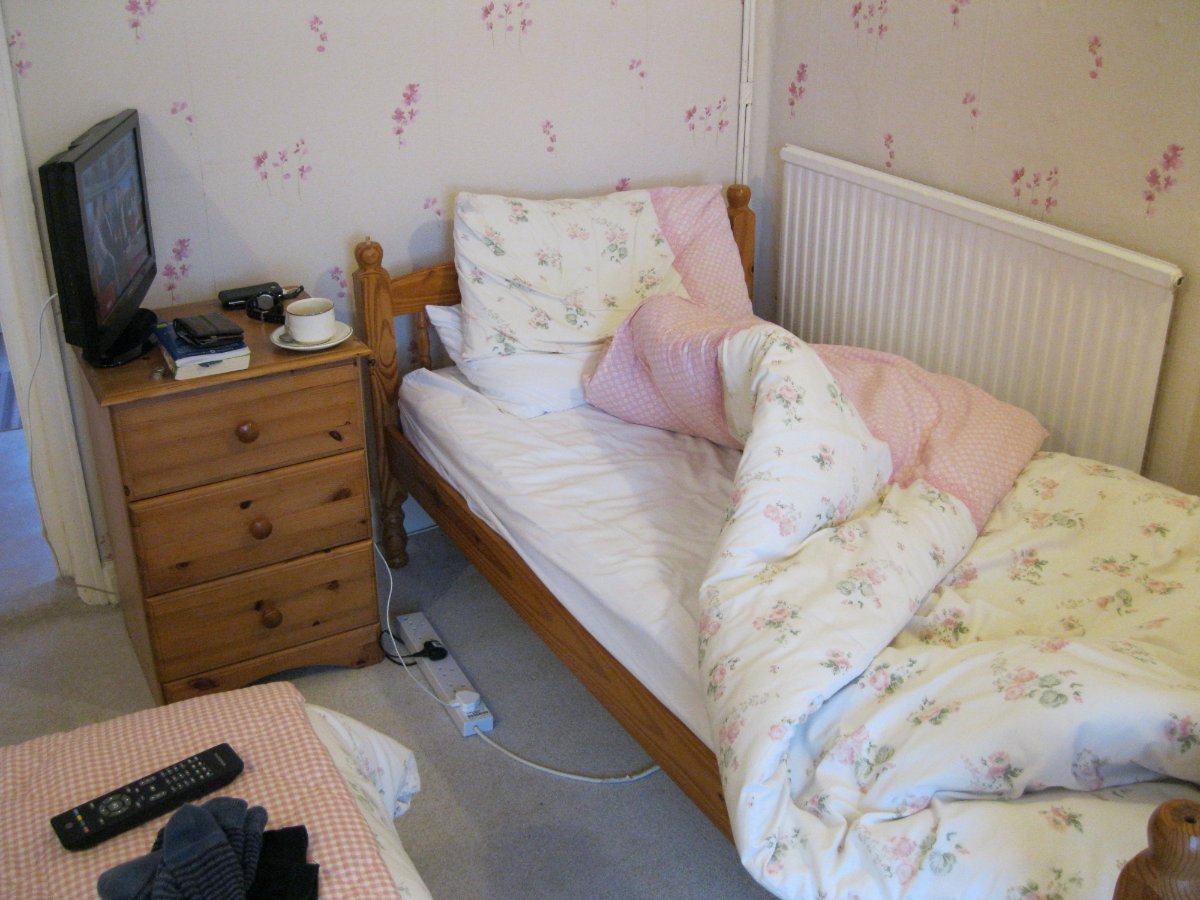
Everything about breakfast was uninviting and not a little unnerving: from the surly, monosyllabic enquiry from mine host as to whether I wanted coffee or tea, to his generous query as to: “One slice of toast or two?” In the event, one slice of the limp, white, anaemically toasted bread was quite enough, particularly since he could not even offer the absolute necessity for a civilised breakfast: baked beans.
My review of what was by far the worst accommodation I have ever stayed in recorded that it had “all the charm of an unflushed toilet”. It’s truly the sort of grubby establishment where you wipe your feet on the way out. Had I checked on Trip Advisor before I booked, I would have been warned off by the very first entry, which read: “You would be better off sleeping on the beach.” Spot on!
Things carried on in much the same vein in my Portreath guest house; another curious establishment, where image and reality diverge wildly. The image, as set out on their website, was of a place where “nothing is too much trouble” and where the owners “go the extra mile” to make their guests’ stay enjoyable. My experience suggested otherwise.
My room was a gloomy ‘inner sanctum’, with no ventilation or window to the outside world (how did they get this past the building inspectors?), no heating, other than a small plug-in electric radiator, and (again!) no shower gel or shampoo. I should have guessed at the paucity of genuinely attractive features when they had found it noteworthy to mention their “fluffy towels” as a selling point on the website. I also found the list headed “Do’s and Don’ts” pinned prominently on the wall to be really inhospitable and not a little inconsistent with their claim to be “welcoming”.
Last in the hall of shame is my accommodation in Portloe, where I was allocated a room with the smallest shower/toilet I’d ever seen. Without exaggeration, when sat on the toilet my feet were in the shower stall. All this might be acceptable in a homeless shelter or low-grade bunk house, but I really do think that charging £50 per night for such accommodation is truly taking the p*ss (and in this room you didn’t have far to take it).
In conclusion, it’s worth emphasising that I slept away from home for over 40 nights and that the vast majority of B&Bs were comfortable and very welcoming (see my five best B&Bs). But I was shocked and surprised at just how many fell well below what any reasonable traveller would be entitled to expect.
A 633-mile pub crawl
On a positive note, I was (generally) far luckier in my search for more-than-halfway-decent drinking establishments. Apart from the path, the natural post-hike habitat of the coast walker is the pub, preferably an old one selling a locally brewed real ale.
I had also decided that, as a subsidiary ‘challenge’, I would see how many different real ales I could sup. I was aware that this challenge might hospitalise me before the walking one did but decided that, as I was not on an SAS endurance march, I should enjoy it as much as possible – and for me enjoyment is closely correlated with beer drinking.
There are countless fine pubs and bars around the SWCP and I visited at least one every night of my walk. We are also so fortunate in having a plethora of excellent breweries in the south west, ranging from small backyard outfits supplying a local area, to the ubiquitous big boys producing industrial quantities of ale and distributing it across the region. So, I had plenty of choice of different ales in pursuit of my ‘real ale challenge’, although I was surprised at the number of ‘barren’ stretches, where I had to mark time. Unsurprisingly, the hostelries I visited also threw up a few characters who kept me entertained on the evenings when I didn’t have Pat to keep me company.
The first really memorable pub I visited was the splendid White Hart in Bideford. A cosy and unprepossessing ‘back street boozer’, this17th-century, grade-II-listed building has been a public house since records began. I enjoyed a couple of pints of spectacularly well-kept ale from the Forge Brewery at Hartland in friendly, relatively sober company. I felt glad that I’d ignored the attractions of what was advertised as “Bideford’s premier nite spot”, Caesar’s Palace, in favour of this fine establishment. I slept well for some unknown reason.
In Bideford’s Burton Museum and Art Gallery I learnt about the cult that developed around Charles Kingsley, the writer and great social reformer. Then in a less salubrious pub than the White Hart I had my first, but sadly by no means last, encounter with a cult of a very different kind – one devoted to tea-time drinking.
When you work full time for a living in a fairly conventional job, you are totally unaware that, while you are labouring at your desk mid-afternoon, the pubs are filling up with a variety of regulars, many of whom (as my old mum would say) seem to have “had enough”, even at such an early hour. Most of these folk are benign enough and, on many occasions, positively exude an air of bonhomie, albeit of a strange, terror-inducing kind. However, there are others who just seem to be intent on making complete arses of themselves.
Staggering on to Port Isaac, I found not just one of the best restaurants, but also one of the best pubs of the trip. After a fine dinner at the Slipway Hotel, I retired to the terrace of the Red Lion for a pint and a sunset. Despite the distraction of the loud and rather irritating Doc Martin film crew, this hour would live with me long after I hung up my walking boots.
My first unpleasant pub experience occurred in deepest, rural Cornwall, courtesy of the lurid ramblings of a man propping up the bar in a local inn.
This odious individual was around 50 years old and dressed in ‘market-trader chic’, his shiny gold bracelets and chain nicely complementing a belly that spoke of close acquaintance with the products of St Austell Brewery.
His conversation, or rather ‘monologue’, ran as follows. Sweating profusely, ‘gold-chain man’ began by explaining to his younger colleagues/carers that “you don’t lose interest in sex just ‘cos you’re getting older”. To dispel any possible misunderstanding, he went on to explain how he still wanted to “sh*g everything in sight”. I don’t imagine this was particularly good news for the local ladies.
From here there was a dearth of really special pubs, as well as a few ropey B&Bs, but I was cheered to reach St Ives, where on a lovely sunny evening I drank a perfect pint of Old Speckled Hen outside the Sloop Inn, watching the sun set over the harbour. This was the most expensive pint of the whole walk, but was well worth it for the location and view.
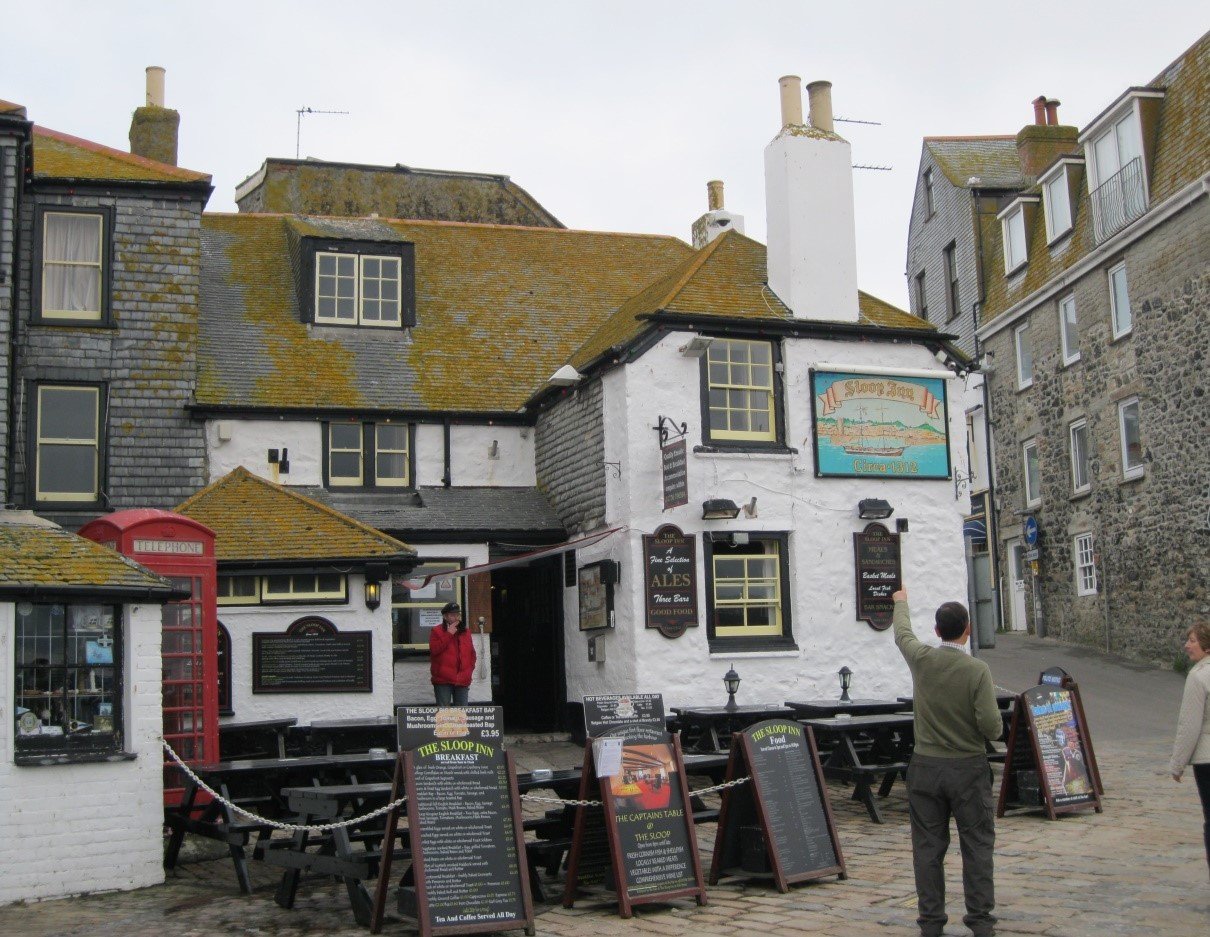
A perfect evening in St Ives ended with another pint of St Austell Brewery’s finest and a plate of that Cornish classic, ‘Homity Pie’, at the Lifeboat Inn. I was entertained during my meal by two American women at an adjacent table, who ordered fish and chips but found them too greasy for their refined tastes and proceeded to remove the batter from the fish and dry their chips individually with napkins. A hilarious end to the sort of evening you would like to bottle.
After rounding the Lands’ End and Lizard peninsulas and sampling the fine accommodation and ale in the North Inn at Pendeen, I arrived at decidedly upmarket accommodation in Marazion. The Godolphin Hotel was not our cheapest B&B, but a very pleasant billet with great views from its terrace towards St Michael’s Mount. A good place to put one’s feet up, watch passing kayaks and dinghies while enjoying a pint or two.
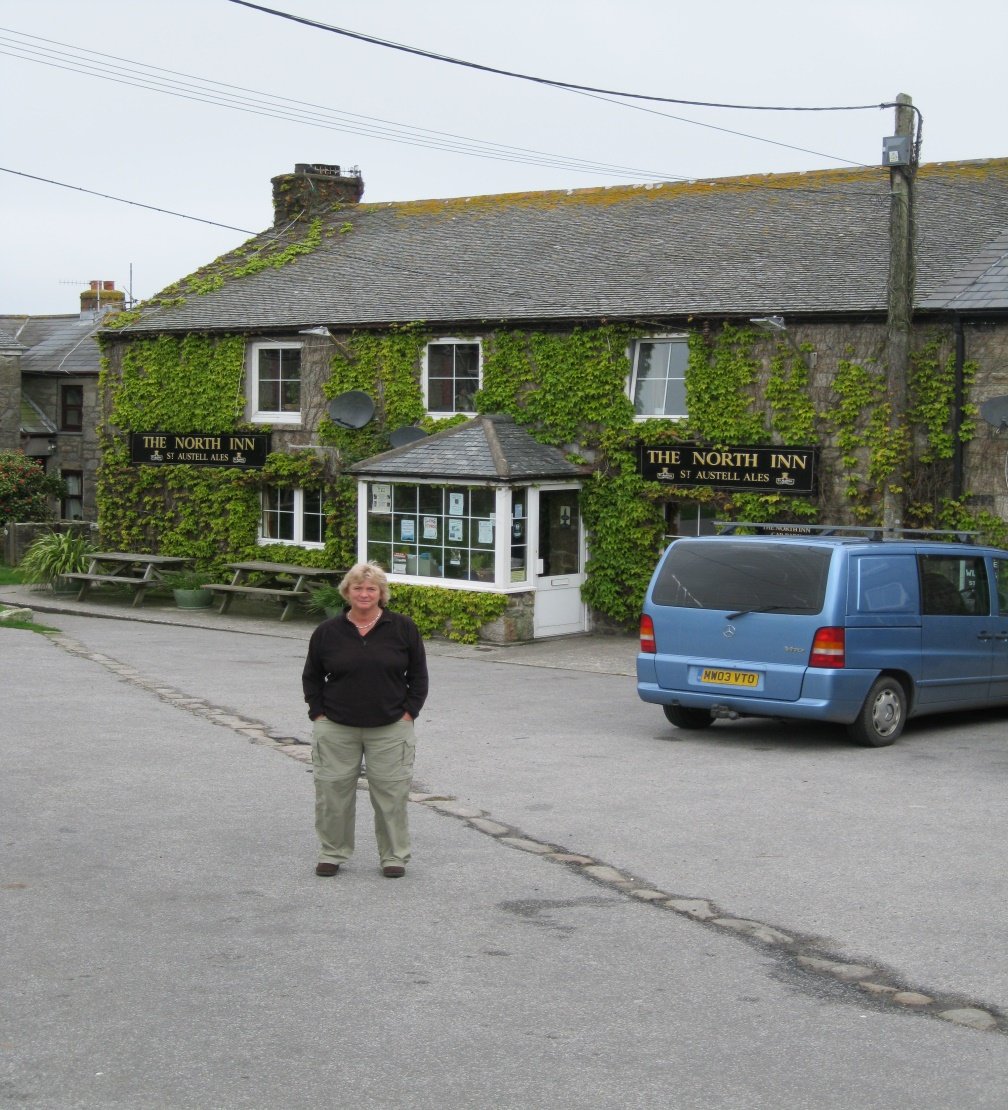
From the sublime to the ridiculous: in the absence of a likely looking pub in Seaton, we dropped into an unlikely looking one on the prom. It was full of incoherent people, who had almost certainly been there since lunchtime – or even breakfast, judging by the state of one or two of them. As I had already discovered, this type of clientele was fairly typical in this sort of seaside pub at teatime. We supped up and quickly escaped while the going was good.
A new ale to add to the ‘real ale challenge’ list eluded me in Weymouth and growing frustration led me to consider diversifying into cider. However, after stepping over a group of revellers leaving a cider bar, I decided against it. To be fair, one of this group showed great dignity and left the bar with his head held high – the trouble was, his feet were held even higher.
Also in Weymouth, I dined in a functional and pretty soulless pub on a residential estate near my B&B. On the credit side, this was the cheapest meal and beer of the whole trip; however, my table near the dartboard brought the constant threat of a player scoring a double top on my forehead and tended to make for a rather nerve-racking and hurried dining experience.
Passing possibly the most photographed locations of the whole coast path – Durdle Door and Lulworth Cove – I pressed on to the Square and Compass in Worth Matravers, a pub I’d place near the top of my list of favourite SWCP pubs. Dating from 1736 when it was ‘The Sloop’, I’m not surprised this is a popular one with walkers given the excellent selection of fine ales and ciders from the barrel. There is very little space inside, but that doesn’t matter, because everyone sits outside on the wall or in the front garden, enjoying a panoramic view over the English Channel.
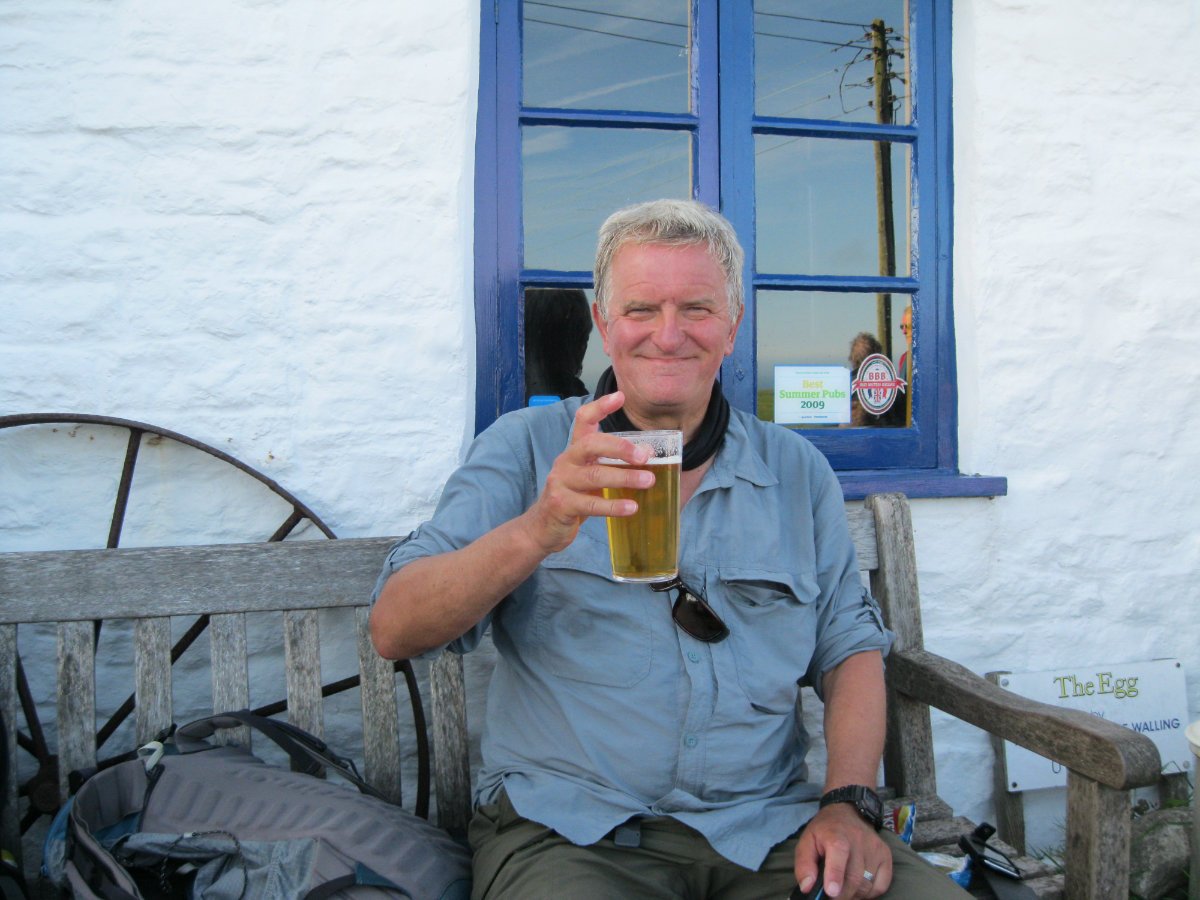
I reached a milestone in the King of Prussia in Fowey, where we enjoyed a delicious meal and I clocked up my 50th different beer. With the crowd’s applause ringing in my ears, I raised my bat but refused to return to the pavilion while ‘not out’ (cold), and resolved to push on towards the century. In fact, I fell well short of that target and only managed a further four different ales before the finish.
After a day of tiring ups-and-downs on a rugged, wild stretch of Cornish coast, it seemed rude on our arrival at Polperro to walk past the Blue Peter. An excellent old pub situated at the end of the quay, it was one of the first buildings we passed coming off the path, but at 6.30pm seemed to be full of drunks – evidence again of the afternoon drinking phenomenon found earlier.
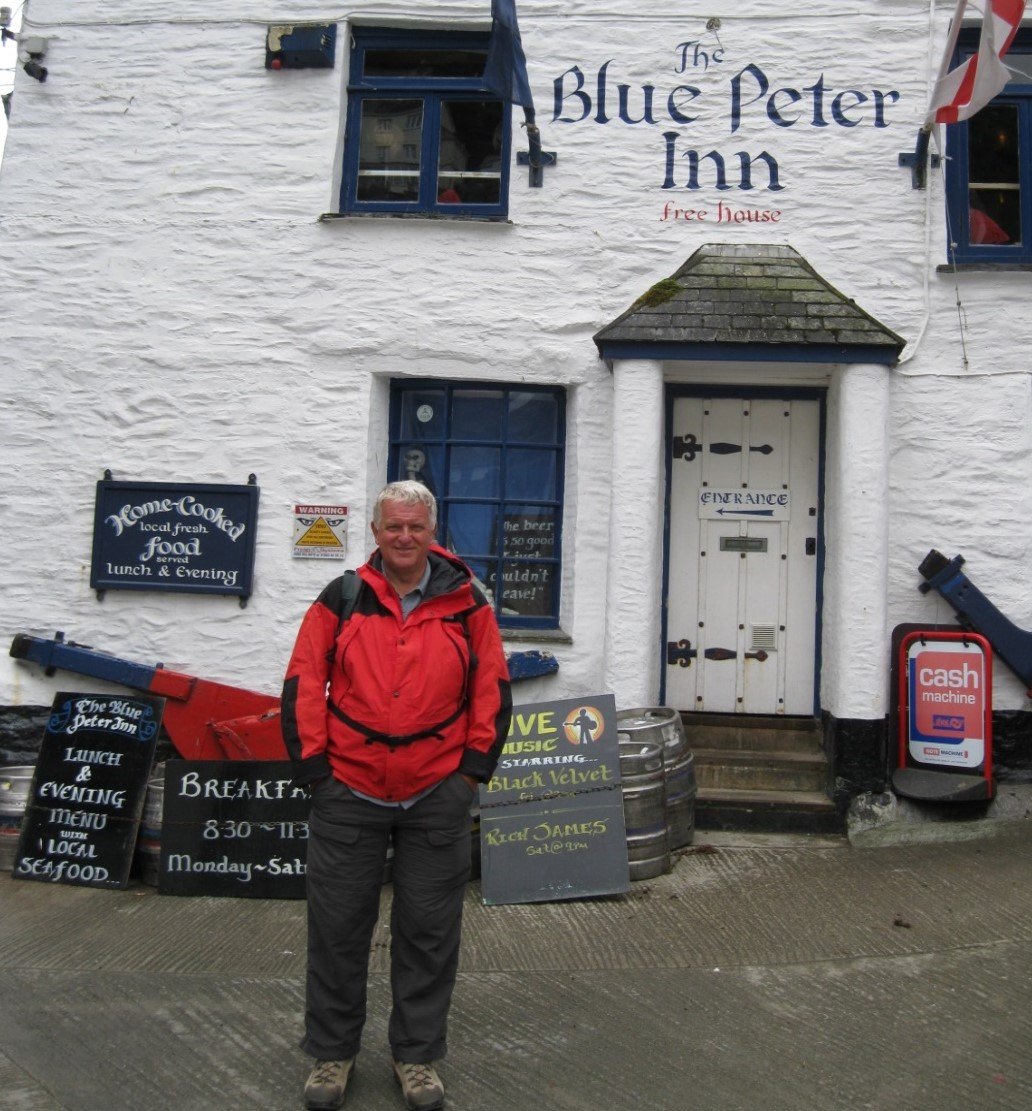
Last, but not least, in my gallery of noteworthy boozers is the Dolphin on the Barbican in Plymouth – a fantastic old pub and one-time home-from-home for artist Beryl Cook, who depicted many of the regulars in her quirky paintings.
Those interested in delving deeper into the wonderful world of coastal watering holes will find more information on the pubs I visited and the ales I drank in my detailed blog.




